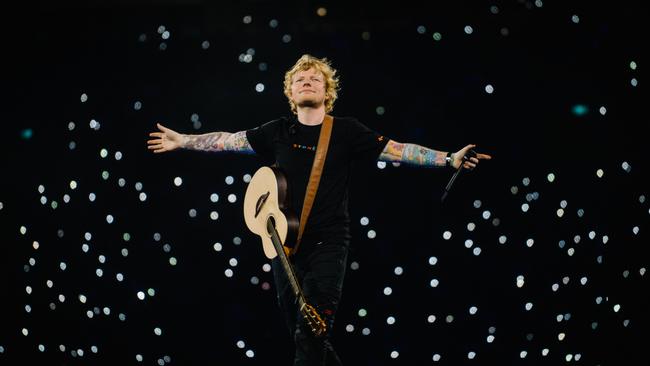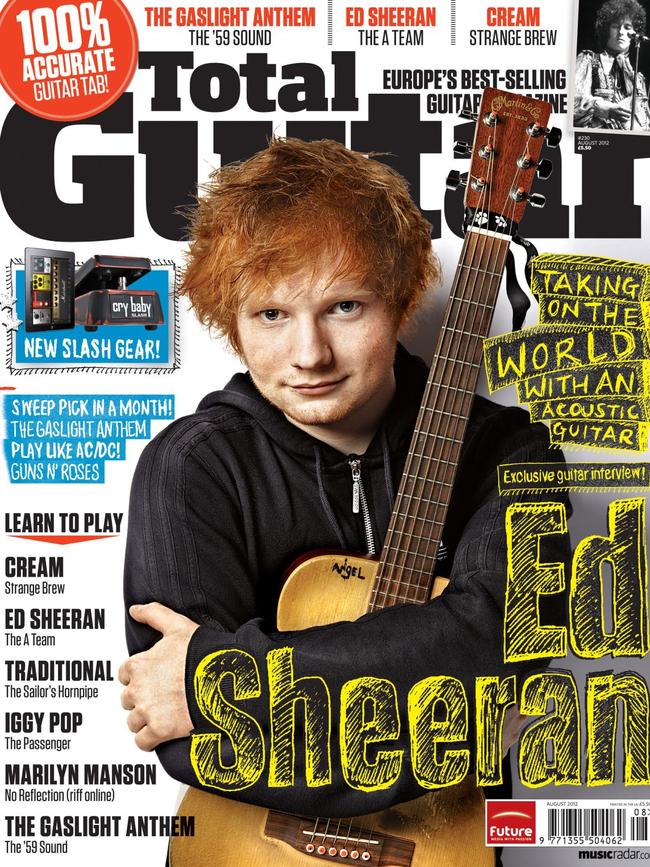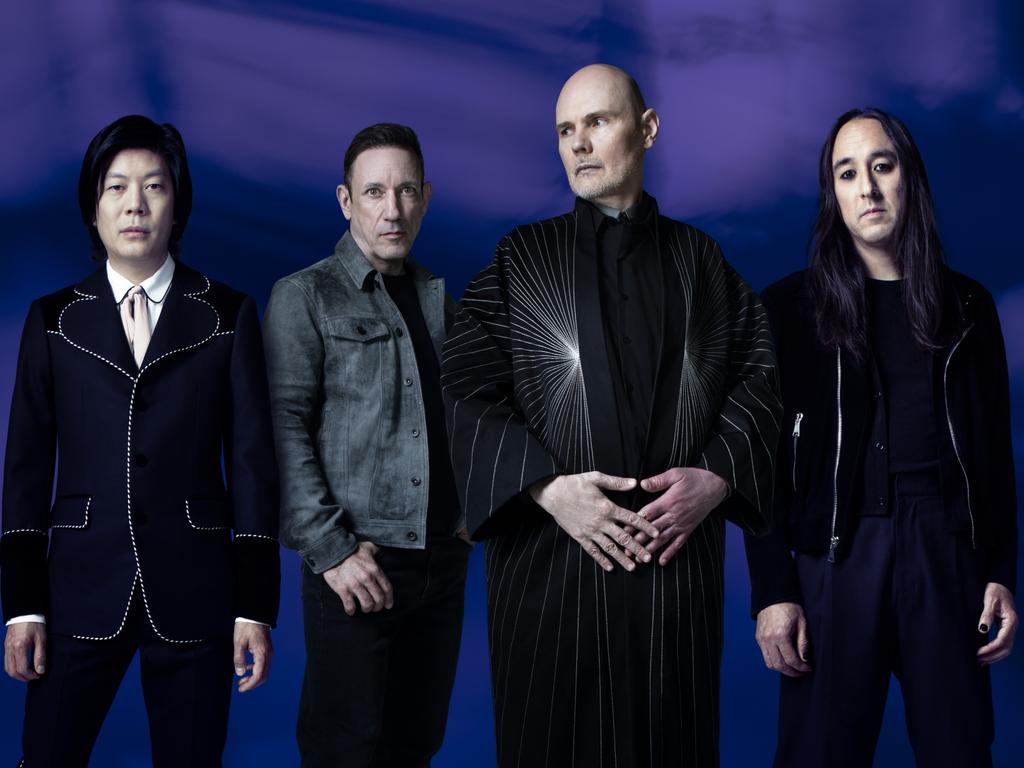How Ed Sheeran became a guitar hero, from pub covers to headlining stadium gigs
In terms of sheer popularity, it’s likely that no other guitarist on the planet has inspired more people to pick up the instrument than Ed Sheeran has — and you can win one of his guitars | ENTER COMPETITION

Two decades ago, Ed Sheeran stood on a small stage in England with a bunch of mates, doing as every young six-string player does: emulating his guitar heroes, dreaming of one day being as good as those genius players, and perhaps making a similarly seismic impact.
At the time, he was giving his best attempt at mimicking the indelible lead melody of a generation-defining anthem by Guns N’ Roses, the US hard rock band whose top hat wearing chief guitarist was bedroom wall pin-up material for millions of impressionable novices.
“I remember being on stage, aged 12, playing Sweet Child O’ Mine,” Sheeran said in a 2021 podcast interview.
“I remember being like, ‘I am Slash! I rocked it! They loved it! I could have crowd-surfed …’”
But this was an anecdote about the fragile nature of memory, particularly in developing adolescent minds, which is why the adult Sheeran interrupted his childhood fantasy with the harsh facts of reality.
“There were probably five people there [in 2003],” he said with a laugh, as a guest on a podcast titled Armchair Expert. “And I’m sure if someone filmed that on a camera phone and I watched it back, aged 12 … I feel like camera phones are ruining the confidence level of kids, because you can watch it back and be like, ‘That actually wasn’t as sick as I remembered …’”
His introduction to learning guitar had taken place only a year earlier, having seen Eric Clapton play Layla in a televised concert for the Queen’s Golden Jubilee in 2002.
That band gig with Sheeran-as-Slash was a short-lived exercise in playing with others as, before long, the musician would begin working exclusively as a solo performer. On his lonesome, he would change the shape of popular music.
Within the space of a decade from that scarcely attended covers show, he would surprise everyone by becoming his generation’s guitar hero.
During his relatively short span of becoming omnipresent in mainstream culture, his impact has dwarfed even that of the top hat wearing shredder, as well as contemporary contenders for the crown including Kevin Parker (aka Australian musician Tame Impala, aged 37) and the country-muso-turned-pop-superstar Taylor Swift (33).
In terms of sheer popularity, it’s likely that no other guitarist on the planet has inspired more players to pick up the instrument than has Sheeran.
That claim might sit uncomfortably with some, particularly those who dismiss his style of confessional songwriting as wimpy or anodyne.
Unlike archetypal guitar heroes such as Jimmy Page, David Gilmour or Angus Young, the red-headed Brit doesn’t need an electrified Gibson or Fender to pull a crowd.
In counterpoint to deceased greats such as Jimi Hendrix, Eddie Van Halen or Jeff Beck, he doesn’t aim to impress with virtuosic, fleet-fingered fireworks sparking up the fretboard.

Instead, Sheeran has spent much of his 12 or so years in the spotlight playing simple chords, strummed on acoustic guitars, while writing and performing songs that connect directly to the hearts and minds of the masses.
Throughout that time, he has skilfully included technology in his act, by using a loop station to live-record, layer and build his sound into a stirring, symphonic, percussive melange.
That’s a neat trick which rarely fails to impress even the most cynical spectator – but by and large, Sheeran’s unique selling point is that he writes simple pop songs with beautiful melodies, occasionally spliced with fast-paced, hip-hop vocals.
What he’s been doing on stages small and large since he was a teenage dreamer is something that can be learned by just about anyone, yet has never been done before at such a massive scale. In an era where the longstanding dominance of rock ‘n’ roll has been superseded by the influence of pop and hip-hop performers, new guitar heroes are thin on the ground, and no single musician has done more to boost the appeal of the totemic instrument.
Sheeran’s raw numbers don’t lie: in Australia alone, he has racked up some eye-popping sales achievements spanning both the recorded and live music sectors.
His longest-running No.1 single on the ARIA chart is Shape of You, which spent 15 weeks on top, behind only Tones and I (Dance Monkey, 24 weeks) and The Kid Laroi + Justin Bieber (Stay, 17 weeks).
His 2017 album Divide spent 27 weeks atop the ARIA chart, behind only Dire Straits (Brothers In Arms, 34 weeks), Adele (21, 32 weeks) and Delta Goodrem (Innocent Eyes, 29 weeks).
Just last month, Sheeran broke the biggest single-show attendance record for a ticketed concert in Australian history, after 109,500 gathered to see him at the Melbourne Cricket Ground on March 4, 2023.
Across nine stadium dates on his recent Mathematics tour, about 820,000 Australians saw him play.
His previous run of shows here in 2018 also broke box office records: the Divide tour sold 1,006,387 tickets across Australia and New Zealand, thereby becoming the first tour to break the million barrier in this part of the world.
Globally, Divide was seen by more than 8.88 million people on six continents across 30 months.
Starting in arenas in 2017 and ending in stadiums in 2019, this behemoth earned $US776.2m, which made it the highest-grossing tour of all time.
In the process, Sheeran bested the box office returns of every other touring act on the planet, from pop contemporaries like Swift and Beyonce, to established rock acts such as U2, The Rolling Stones, AC/DC and Guns N’ Roses, the band whose songs he once covered before a handful of onlookers.
At each of the 255 concerts on the Divide tour, the set-up was the same: one man with an acoustic guitar, singing his songs while prodding at a loop station with his sneakers. The presentation was simple, elegant and eminently impressive.
For the Australian shows earlier this year, he was occasionally joined by a handful of other musicians for a few songs – but the bulk of each show was another solo performance, this time “in the round”, with the stage positioned in the centre of each stadium.

One of the audience members at Sheeran’s recent two-night stand in Melbourne was Mark Seymour, the singer-songwriter and frontman of rock act Hunters & Collectors.
From the second level at a packed MCG, he had the deeply unusual and flattering experience of watching and listening as Sheeran performed the iconic Hunters’ song Throw Your Arms Around Me, in tribute to their mutual friend Michael Gudinski, the late Mushroom Group boss.
“There’s so much theatrical detail in that show; he’s almost invented a genre,” Seymour tells Review. “He’s cornered this genre of musical presentation.
“Taking it to that [stadium] level is like cultural wizardry; it’s been done once, and no one will ever repeat it. Technically, it’s just so specific, and it’s all incredibly tightly orchestrated.”

At 66, Seymour has been working in and around music for more than 40 years.
When asked for his impressions of Sheeran’s instrumental playing, in the historical context of Hendrix, Page and Clapton et al, he, too, was reaching for superlatives.
“You look back on those guys in that era, when the idea of the technically gifted lead guitar player was the thing of choice back in the day: the notion of having really good chops was admired by many, and I think he’s like that,” says Seymour. “He’s definitely got chops, mate; serious chops.”
Born in the British town of Halifax, West Yorkshire, in 1991, Sheeran has never put on a costume or a mask before he walks on stage.
With Sheeran – whose public attire has consistently consisted of hoodies, T-shirts, jeans and sneakers – what you see is what you get. Airs and graces are few, resulting in an earthy, relatable persona that endears him to young and old.
By the time he was carting a guitar around London, having left high school at 16, the singer-songwriter had well and truly revealed his obsessive nature towards music.
It began soon after he got his first guitar, having seen Clapton play Layla on TV, aged 11; before long, he was immersing himself in learning to play it seven hours a day, and rebuffing friends’ requests to join him outside.
Into his mid-teens, Sheeran’s keen ears had amassed a diverse range of influences from his musical interests, which fed into his own songwriting.
There were four chief acts from which he drew inspiration: he loved the open-hearted, communal vibe of Irish folk artist Damien Rice; the improvisation and people skills of British hip-hop/folk duo Nizlopi; the “one man band” approach of US fingerstyle guitarist Preston Reed, and the hypnotic loops of Irish singer-songwriter Gary Dunne.
None of these are mainstream names: of these four key influences on one of the biggest pop artists in history, most people – even most of Sheeran’s fans – have probably heard of none of them.
In Australia, only Rice has achieved a reasonable level of fame: the Irish singer-songwriter will soon play seven shows in theatres here, from May 12 (Sydney) to May 24 (Gold Coast). When he turned 16 in 2007, Sheeran booked Gary Dunne to play at his house, with a couple of dozen friends in attendance. The birthday boy filmed the gig, and stayed up late with the guest muso, deconstructing all his songs and grilling him on how to use the Boss loop station that Dunne had employed to stunning effect.
The teenager bought one the next day, and has been using it since. This looping technology allows a skilled user to build a dense wall of sound from just a few well-chosen musical elements – a strummed chord or lead melody here; a breathy vocal sample or tapped rhythm there.
As Sheeran later told the BBC: “It doesn’t take that long to learn. But it took about four years to get the timing right and get a sixth sense about when to press it without looking down.”
That sixth sense was honed through incessant gigging: after moving from Suffolk to the British capital, he played 312 shows in 2009 alone, at any pub or small stage that would have him.
In August 2012, a year after the release of his mega-selling debut album, titled Plus, Europe’s best-selling guitar magazine put Sheeran on the cover, cradling one of his beloved Little Martin instruments, accompanied by a headline: Taking on the world with an acoustic guitar.

Inside, Total Guitar readers could learn to play Sheeran’s song The A Team, as well as more traditional guitar mag fare such as tracks by Cream, Iggy Pop and Marilyn Manson.
That editorial decision was telling in itself: for decades, the stock-in-trade for the cover of these monthly publications was to feature musicians – mostly male – with their electric axe.
By that point in 2012, though, even Total Guitar couldn’t deny which way the wind was blowing: one of the most popular artists in the world was a guitarist whose weapon of choice was a small-bodied Martin acoustic.
“Going on trains, sleeping on sofas, playing around the country, you can fit a lot in the guitar’s case,” Sheeran, then 21, told Total Guitar. “And in the little pouch you can have your toothbrush and toothpaste and phone chargers. So it was my suitcase with a guitar in it and that was very convenient.”
He became an ambassador for Martin Guitars, who in 2013 created a signature model acoustic in his name. That same year, though, Sheeran was gifted another guitar from his friend Gary Lightbody, frontman of Scottish rock band Snow Patrol: a “Wee Lowden”, a small-bodied acoustic designed by George Lowden.
Based in Northern Island, Lowden is a boutique luthier without the brand awareness of established names such as Gibson, Fender, Martin or even Maton, the Australian company.
Yet the Wee Lowden chimed beautifully in Sheeran’s ear, and the musician began filling his house with these handmade instruments: today, he reckons there’s one in every room of his home.
In 2019, Sheeran partnered with Lowden for a new product line aimed at aspiring musicians, from a shared vision to make quality guitars with great playability and tone accessible to a wider range of players.

It is this line of guitars, named Sheeran by Lowden, that the artist now plays when working on new music, such as his upcoming fifth album, titled Subtract, to be released on May 5.
He also plays them on stage, including at the first show of his recent Australian tour at Brisbane’s Suncorp Stadium on February 17, which was Sheeran’s 32nd birthday.
Even having watched him play five years earlier, on his mega-selling Divide tour, Review was mightily impressed by the sheer polish on display that night across two hours. Before about 57,000 people, his performance was breathtaking, and at the centre of it all – on a stage that slowly spun like a vinyl record – was a small-bodied acoustic guitar, which he picked, strummed, drummed and manhandled to dazzling effect.
Frontier Touring presented the shows, and its chief executive Dion Brant tells Review: “On a spinning stage, where there’s five loop pedals, and he’s able to set up his loops – and remember which loop it is as he’s stopping it, or re-recording the next part three pedals over, as the stage spins around – it’s a skill that I just can’t even fathom. That is amazing: the ‘guitar hero’ thing fits, as well as the songwriting that goes with that.”
At the MCG, Mark Seymour found himself pondering a question that had never crossed his mind before: what brand of guitar does Ed Sheeran play?
“The idea of playing an acoustic and creating that level of sound is a paradox that would probably excite the minds of young kids,” the Hunters & Collectors frontman tells Review. “They’d be saying, ‘Hang on, that’s not an electric guitar, how does that work…?’ Boys particularly; little trainspotter teenagers would find that fascinating, I think. If I was 14 or 15 now, that would interest me: How is he doing that?’
“And that’s a cool thing; it just gets kids interested in music,” says Seymour. “I remember I started doing music in high school and I found it really boring. I think music’s a great thing, especially for teenagers, to do; to indulge in. It’s a really important part of life, and any artist who manages to galvanise the imagination of kids is doing a huge amount of good work, for the great of society.”
Part of the fun of watching Sheeran play is in witnessing someone who is the best in the world at what they do.
Only one person is equipped to consistently fill stadiums to perform what is essentially a solo show, and it’s him. His mastery functions as a living example of what one person can achieve if they put their entire being into honing that skillset.
Plenty of singer-songwriters shoot for the moon and barely reach the treetops, never mind the stars. Sheeran aimed his rocket towards space, colonised the luminous satellite, then established a throne inside a moon base that will endure as long as people listen to music.
Ed Sheeran’s fifth album Subtract is released on May 5 via Atlantic.
Want to win Ed Sheeran’s signature guitar? Enter below
In recent weeks, Review has been playing a Sheeran by Lowden acoustic guitar. Made in Northern Ireland and hand-numbered as 35 of 50 limited edition instruments to mark his recent tour, it also features an Australian blackwood Mathematics fingerboard inlay.

With its smaller than usual body, the handsome guitar sits nicely under the arm, and its size doesn’t mean a smaller sound. If you believe in the totemic significance of particular objects, it’s easy to feel connected to the man himself as you fret its notes.
There was a curious bit of coincidence at play when Review tuned its six strings for the first time using a phone app: the first song that GuitarTuna suggested we learn was not Sweet Child O’ Mine – tellingly, it was Sheeran’s Perfect, one of the world’s most famous love songs, and a modern wedding standard.
So we learned it, and as a special giveaway from Lowden Guitars, you now have the chance to do the same on the very same instrument.
You may not have Ed’s serious chops or stadium-sized ambitions, but there is still much pleasure to be gained from sitting quietly in a room, listening and playing music, and dreaming of what comes next.
To win a Sheeran by Lowden limited edition Australian tour guitar and gig bag, RRP $1439, leave a comment below telling us, in 25 words or less: Why is Ed Sheeran your guitar hero? (Competition closes at 11.59pm AEST on Friday May 5 2023.)





To join the conversation, please log in. Don't have an account? Register
Join the conversation, you are commenting as Logout